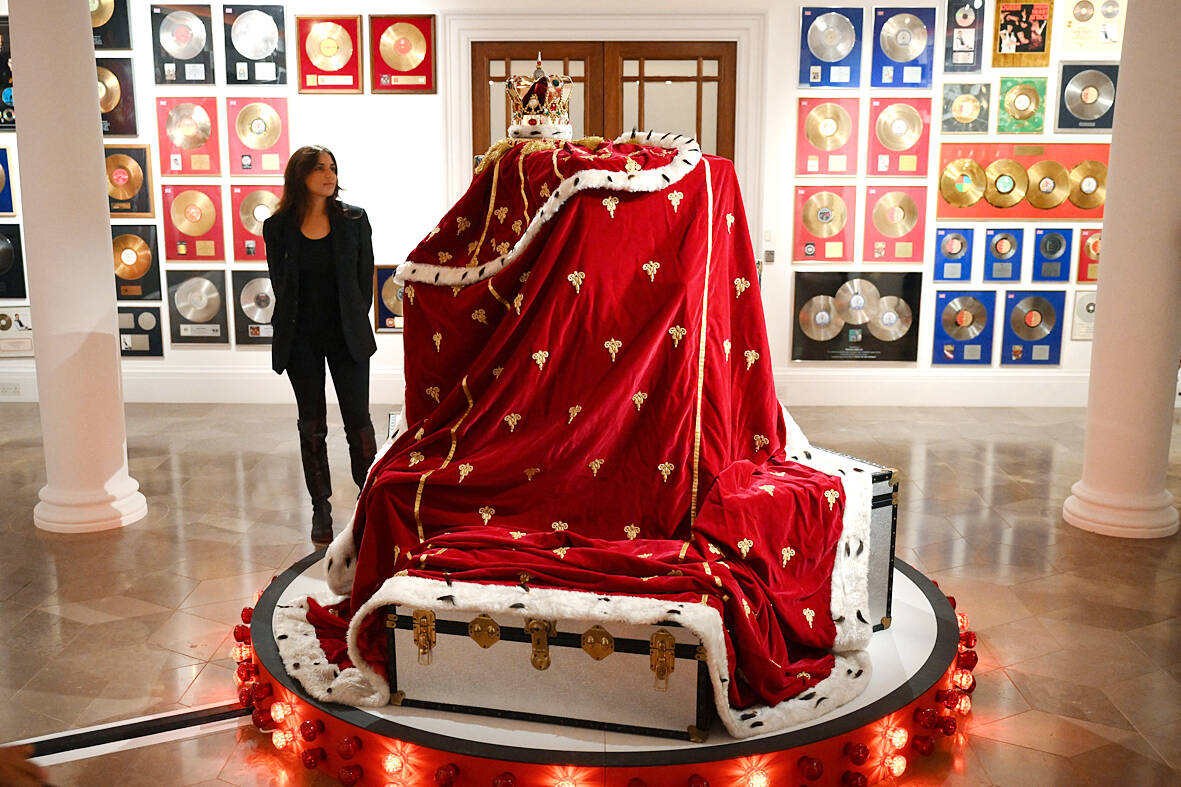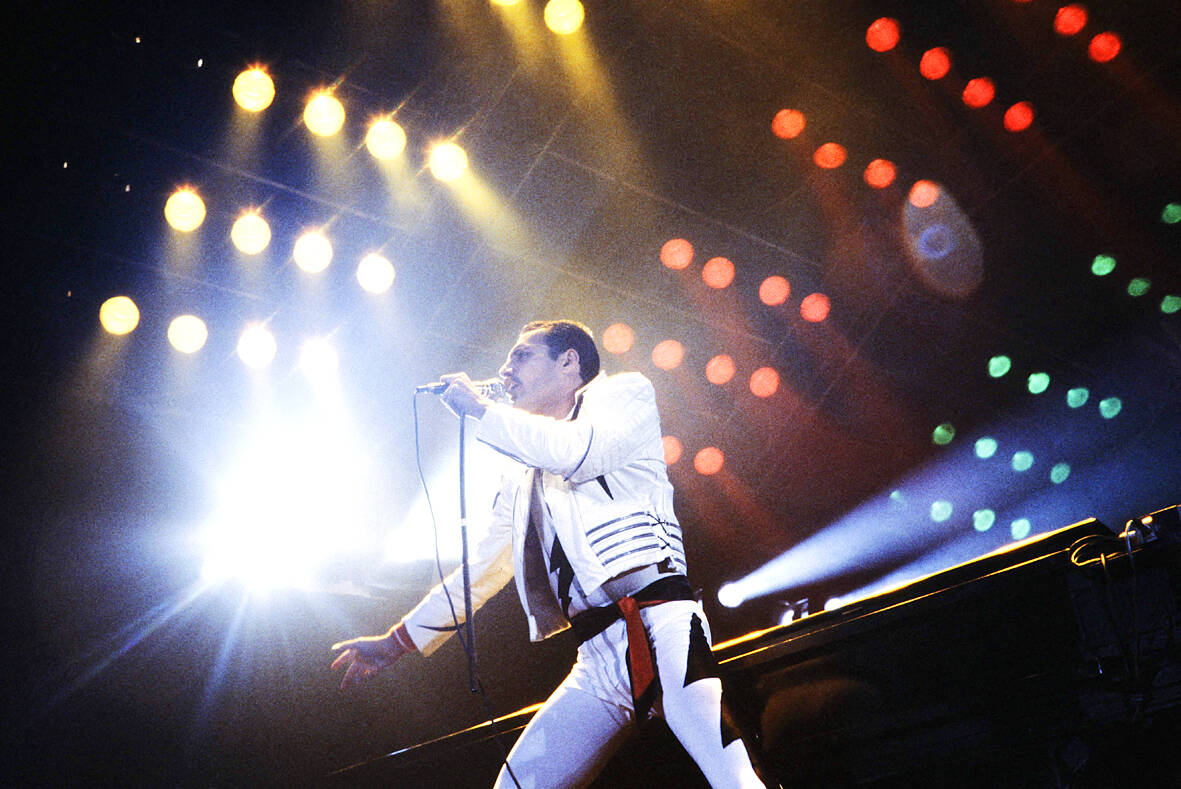Thousands of items belonging to the charismatic Queen frontman Freddie Mercury, from manuscripts of his band’s biggest hits to furniture, paintings and knick-knacks are currently on auction in London.
Among the highlights of the Sotheby’s “evening sale,” which will be followed by two other live auctions and three online sales, is Mercury’s piano.
The Yamaha quarter-tail piano was bought by Mercury in 1975 and was used to create almost all of his greatest songs.

Photo: AFP
It is expected to sell for between £2 million and £3 million (US$2.5 million and US$3.75 million).
Also on sale is the original manuscript for epic hit Bohemian Rhapsody, whose 15 pages of pencil and ballpoint pen remarks reveal the different directions Mercury envisaged for the track.
It also reveals that it was originally going to be called Mongolian Rhapsody.

Photo: AFP
Paintings by Chagall, Dali and Picasso that adorned Mercury’s home, as well as the last painting he bought a month before his death from AIDS in 1991 — an oil on canvas by James Jacques Joseph Tissot — will also go under the hammer.
AUCTION FAN
All the items for sale are from Mercury’s home, Garden Lodge, in west London. The property’s green door, covered in fan graffiti, is one of the lots.
The entire collection is being offered for sale by Mary Austin, a close friend and one-time fiancee of Mercury’s.
“Mary Austin has lived with the collection and has cared for the collection for more than three decades,” said Gabriel Heaton, a books and manuscripts specialist at Sotheby’s.
Mercury “was not interested in having a museum of his life but he loved auctions,” to the point of being a regular at Sotheby’s sales, said Heaton.
Austin believes the artist — who was 45 when he died — would have “loved” this sale, he added.
Some 1,469 lots will go under the hammer at the famous London auction house, whose facade has been decorated with a huge moustache for the occasion. Many reveal another side of Mercury, including his passion for cats and for Japan — as evidenced by his collection of kimonos and prints.
MOUSTACHE COMB
Mercury’s most flamboyant stage costumes, Hawaiian shirt and Superman tank top will also find new homes along with his personal polaroids and legendary snapper Mick Rock’s shots.
The finest bottles from his cellar, such as Dom Perignon champagne, will be up for grabs alongside more intimate items, such as a book of personally annotated poetry and a moustache comb.
Among the more playful items are a set of games including travel Scrabble, at which Mercury excelled.
Before the sale, the auction house hosted the collection at a month-long exhibition, open to the public free of charge. Sotheby’s estimated when the auction was announced in April that the lots would fetch at least £6 million. Part of the proceeds will be donated to the Mercury Phoenix Trust and the Elton John Aids Foundation, two organizations involved in the fight against AIDS. Sotheby’s says it is the largest collection, by volume, of a cultural icon to go to auction since the Elton John sale in 1988, when 2,000 lots sold for a total of £4.8 million.

Oct. 27 to Nov. 2 Over a breakfast of soymilk and fried dough costing less than NT$400, seven officials and engineers agreed on a NT$400 million plan — unaware that it would mark the beginning of Taiwan’s semiconductor empire. It was a cold February morning in 1974. Gathered at the unassuming shop were Economics minister Sun Yun-hsuan (孫運璿), director-general of Transportation and Communications Kao Yu-shu (高玉樹), Industrial Technology Research Institute (ITRI) president Wang Chao-chen (王兆振), Telecommunications Laboratories director Kang Pao-huang (康寶煌), Executive Yuan secretary-general Fei Hua (費驊), director-general of Telecommunications Fang Hsien-chi (方賢齊) and Radio Corporation of America (RCA) Laboratories director Pan
The consensus on the Chinese Nationalist Party (KMT) chair race is that Cheng Li-wun (鄭麗文) ran a populist, ideological back-to-basics campaign and soundly defeated former Taipei mayor Hau Lung-bin (郝龍斌), the candidate backed by the big institutional players. Cheng tapped into a wave of popular enthusiasm within the KMT, while the institutional players’ get-out-the-vote abilities fell flat, suggesting their power has weakened significantly. Yet, a closer look at the race paints a more complicated picture, raising questions about some analysts’ conclusions, including my own. TURNOUT Here is a surprising statistic: Turnout was 130,678, or 39.46 percent of the 331,145 eligible party

The classic warmth of a good old-fashioned izakaya beckons you in, all cozy nooks and dark wood finishes, as tables order a third round and waiters sling tapas-sized bites and assorted — sometimes unidentifiable — skewered meats. But there’s a romantic hush about this Ximending (西門町) hotspot, with cocktails savored, plating elegant and never rushed and daters and diners lit by candlelight and chandelier. Each chair is mismatched and the assorted tables appear to be the fanciest picks from a nearby flea market. A naked sewing mannequin stands in a dimly lit corner, adorned with antique mirrors and draped foliage

The election of Cheng Li-wun (鄭麗文) as chair of the Chinese Nationalist Party (KMT) marked a triumphant return of pride in the “Chinese” in the party name. Cheng wants Taiwanese to be proud to call themselves Chinese again. The unambiguous winner was a return to the KMT ideology that formed in the early 2000s under then chairman Lien Chan (連戰) and president Ma Ying-jeou (馬英九) put into practice as far as he could, until ultimately thwarted by hundreds of thousands of protestors thronging the streets in what became known as the Sunflower movement in 2014. Cheng is an unambiguous Chinese ethnonationalist,